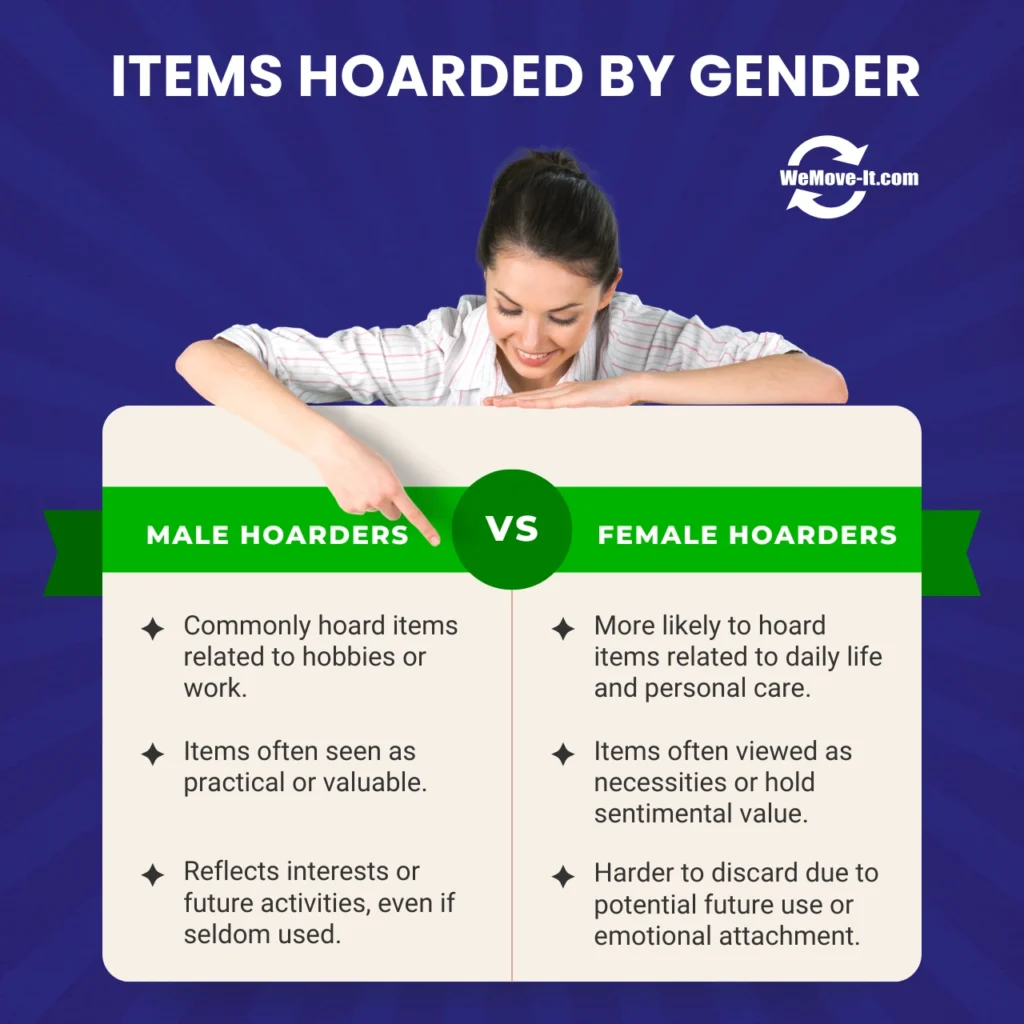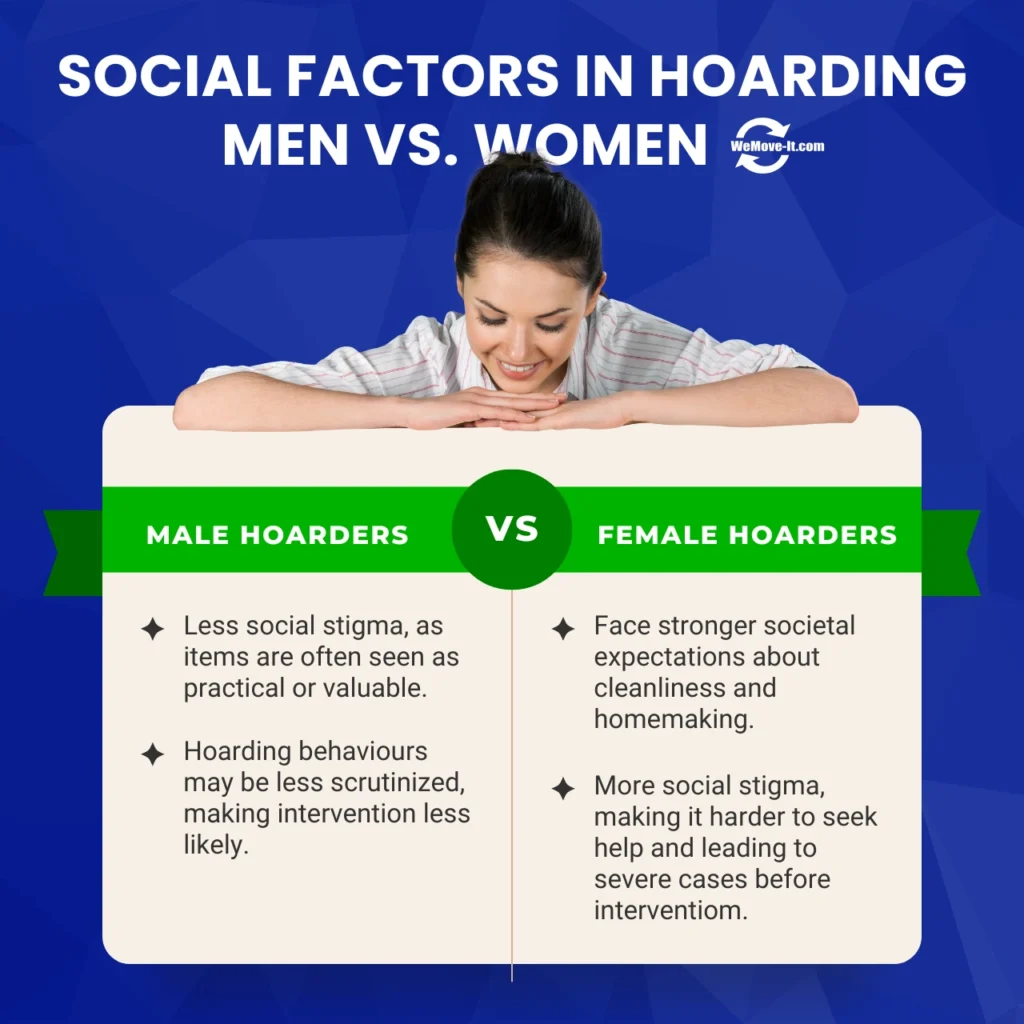When we think about hoarding, many of us might picture the scenes we’ve seen on television shows like Hoarders, where homes are filled to the brim with belongings, making them nearly uninhabitable. Interestingly, these shows often feature women as the primary hoarders, leading to a common perception that hoarding is more prevalent among females. But is this truly the case? Are there actually more women who struggle with hoarding than men, or is this just a result of how the media portrays the disorder? Let’s review the research and see what the evidence says about gender differences in hoarding.
Gender Differences in Hoarding
When trying to determine whether most hoarders are male or female, the answer isn’t as straightforward as you might think. According to most published research, hoarding disorder appears to affect both males and females similarly in terms of the overall prevalence of the condition. However, there are some gender differences in the way hoarding behaviours manifest.
A study published in ScienceDirect found that males and females generally have similar symptomatic presentations of hoarding disorder. This means that both genders are equally likely to experience the core symptoms of hoarding, such as difficulty discarding items, distress associated with discarding, and the accumulation of clutter. However, the ways in which these behaviours are expressed, and the specific items that are hoarded can differ between the genders.
For instance, women may exhibit higher levels of acquisition behaviours compared to men. Acquisition behaviours refer to the tendency to acquire or collect new items, even when there is no immediate need for them. This can include compulsive shopping, collecting free items, or taking in things that others discard. The difference in acquisition behaviours could explain why some studies suggest that female hoarders may accumulate more items than their male counterparts.
Types of Items Hoarded

The type of items that people with hoarding disorder tend to accumulate may also vary based on gender. Research suggests that women are more likely to hoard clothing, personal care items, and household goods. These items are often related to daily life and can be seen as necessities, which might explain why they are more challenging to discard. Women might feel that these items have potential future use or sentimental value, making it harder to let go.
Men, on the other hand, are more likely to hoard items related to hobbies, work, or electronics. These can include tools, old electronics, magazines, and other items that might be perceived as useful or valuable in the future. Men may also be more likely to hoard items that are related to collecting, such as sports memorabilia or model kits. The items hoarded by men often reflect interests or activities that they plan to engage in, even if they never get around to it.
These differences in the types of items hoarded may also influence the severity and visibility of the hoarding problem. For example, while a large collection of tools or electronics might take up space, it might not be as immediately visible as the accumulation of clothing or household goods. This could lead to differences in how hoarding is perceived by others and how likely it is to be addressed.
Social and Cultural Factors

While the core symptoms of hoarding disorder are similar between males and females, social and cultural factors may influence how these behaviours are expressed and perceived. In other words, societal expectations and gender roles might play a role in how hoarding is manifested and reported.
In many cultures, women are often seen as the primary caretakers of the home. This role can sometimes lead to a greater emphasis on acquiring and keeping household items, which might contribute to the higher levels of acquisition behaviours seen in female hoarders. Women may feel a responsibility to keep items that might be useful to the household in the future, or they might hold onto things that have sentimental value for their family. This sense of responsibility can make it even more difficult to discard items, leading to more severe hoarding behaviours.
On the other hand, men may be more likely to hoard items related to hobbies or work, such as tools, electronics, or memorabilia. These items are often viewed as investments in future activities or projects, even if those projects never come to fruition. Men may justify their hoarding behaviour by viewing these items as valuable or potentially useful, making it harder to recognize when the behaviour has become problematic.
It’s also important to consider how hoarding behaviours are perceived by others:
- Women who hoard may face more social stigma due to societal expectations about cleanliness and homemaking. This stigma can make it harder for women to seek help for their hoarding behaviours, potentially leading to more severe cases before intervention occurs.
- Men, on the other hand, might not face the same level of scrutiny, especially if their hoarding is related to items that are seen as practical or valuable.

This difference in perception can affect how quickly hoarding behaviours are addressed and how they are managed.
How Can Family and Friends Help?
Family and friends play a critical role in supporting someone with a hoarding disorder, regardless of their gender. However, how they approach the situation can make a significant difference. Pressuring a loved one to discard items or criticize their behaviour can lead to increased anxiety and resistance, making the situation worse.
It’s essential to approach the situation with empathy and understanding. Hoarding is not a choice; it’s a mental health disorder that requires compassion and support. Family and friends can help by encouraging their loved one to seek professional help and by being there for them as they gradually improve.
Professional support, such as therapy and hoarder cleanup services, can make a world of difference. By working with professionals who understand the challenges of hoarding disorder, individuals can begin to regain control over their living spaces and their lives.
A Cleaner Home is Only a Phone Call Away
So, are most hoarders male or female? The answer is that hoarding disorder affects both genders similarly in terms of prevalence, but there are some differences in how the disorder manifests. Females may be more prone to acquisition behaviours, which can lead to more clutter accumulation, while men might hoard items related to hobbies or work. Social and cultural factors also play a role in how hoarding behaviours develop and are perceived.If you or someone you know is struggling with hoarding, it’s important to seek help sooner rather than later. The longer hoarding behaviours persist, the more challenging they can become to manage. Professional support, such as that offered by WeMove-It.com, can make a significant difference in creating a safer, healthier living environment. With skilled and professional hoarder cleanup services, we can take the first step toward cleaning your space and reclaiming your life. To schedule a free estimate, call 844-866-8348.



